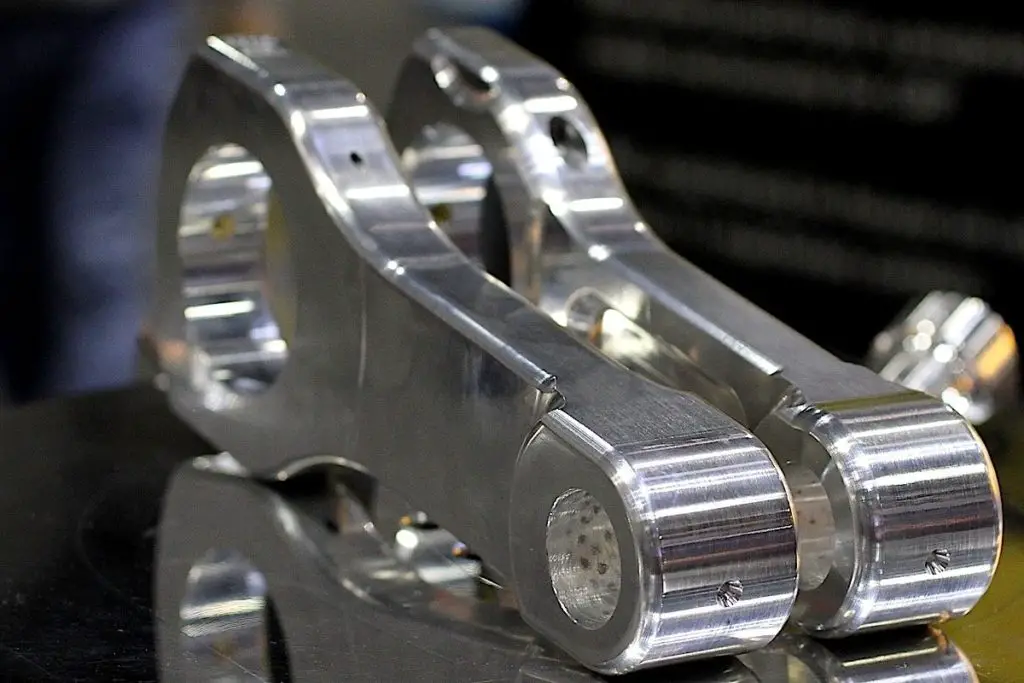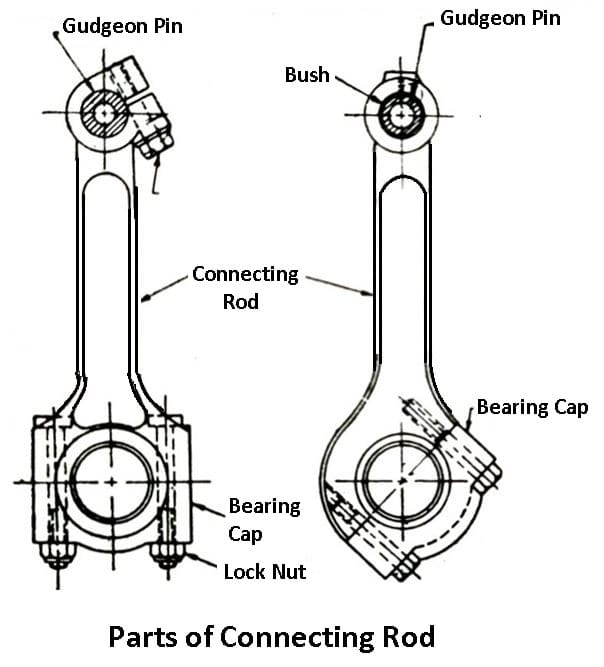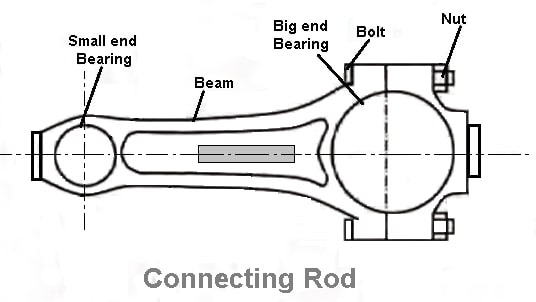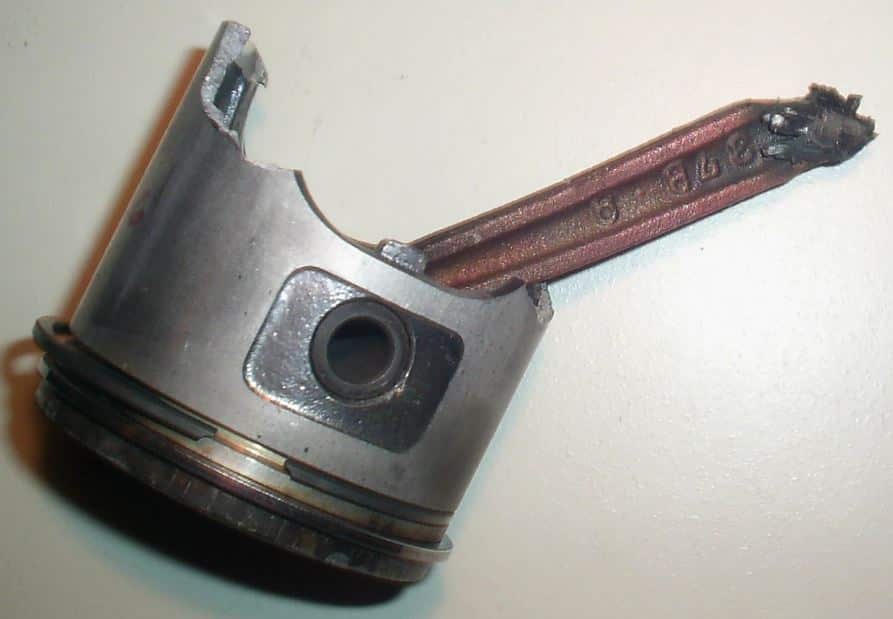In this article, you’ll learn what is connecting rod? How it works? its parts, function, applications, and types of the connecting rod. Explained with a diagram and also download the PDF file of this article at end of it.
Connecting Rod and Types
What is connecting rod?
The connecting rod is a connection between the piston and a crankshaft. It joins the piston pin with the crankpin. The small end of the connecting rod is connected to the piston pin and the big end to the crank pin.
The purpose of the connecting rod is to convert the linear motion of the piston into the rotary motion of the crankshaft.

The connecting rod consists of an I-beam cross-section and is made of forged steel. Aluminum alloy is also used for connecting rods. They are precisely matched in sets of similar weight in order to maintain engine balance.
The lighter the connecting rod and piston, the greater the resulting in power and the lesser the vibration because the reciprocating weight is less.
The connecting rod carries the power thrust from piston to the crankpin and hence it must be very strong, rigid and also as light as possible.
Parts of Connecting Rod
Following are the parts of connecting rod:
- Small End
- Big End
- Bushing
- Bearing inserts
- Bolt and Nut
- Shank
- Wrist pin
- Piston
- Bearing cap

1. Small End
The end at which the connecting rod is attached to the face of the piston pin is known as the small end of the connecting rod.
2. Big End
The end at which the connecting rod is attached to the side of the crank pin is known as big end of the connecting rod.
3. Bush Bearing
Both ends of the connecting rod are fixed with a bush bearing. A phosphor bronze bush is fitted with the solid eye is attached to the small end of the connecting rod.
The Big end is attached to the crankpin. The end is divided into two parts and is supported over the crank bearing shell.
4. Bearing Insert
In the big end of the connecting rod, there is a bearing insert that is connected to the bearing cap, it is known as a bearing insert. These are made in two parts that fit together on the crankshaft. This is the position where the connecting rod travels along the reverse direction.
5. Bolt and Nut
After the connecting rod is fitted with the crank at the bottom, both sides of the big ends are fastened by some bolts and nuts. Thus, by combining these all components the connecting rod is ready to use.
6. Shank
Furthermore, each of the bolt and nuts are employed to connect both the connecting rod and bearing cap. And a section beam is applied it is known as shank. The section of the rod may be rectangular, tubular, and a circular section.
The connecting rod length lies on the ratio of (I/r)
Where,
I = is the length of the shank or beam
r = is the radius of the shank.
7. Wrist Pin
The engine piston is connected to the connecting rod with the help of a hollow hardened steel tube called wrist pin. It is also known as gudgeon pin. Wrist pin goes through the short end of the connecting rod and pivots on the engaged piston.
8. Piston
The piston is connected to the crankshaft with the help of a connecting rod, which is usually shortened to the rod or Conrod. The purpose of the piston is to work as a movable plug in the cylinder, which forms the bottom of the combustion chamber.
9. Bearing Cap
Shell bearings have an adjustment for wear, but it controls the running and the side clearance allows the bearing cap to be tightened correctly.
Construction and Functions of Connecting Rod
There are two types of ends small end and big end bearings. The big end is split at right angles to its length as at (a) or at an angle as at (b), in order that it may be assembled on the crankpin. A cap is fixed to the body of the connecting rod by two bolts and nuts.
Modern engines do not have bearing metal fused to the bore of a big end, but it uses separate low carbon steel bearing shells.

The shell bearing has adjustment for wear but gives the control over running and side clearance, providing the bearing cap to correct fit. Sometimes, thin pieces of metal known as shins are used when spur bearings are employed.
These can be filled thinner to compensate for the wear of the bearing and also to secure the correct bearing clearance between the connecting rod and the crankshaft. The small end is usually a solid eye fitted with a phosphor bronze bush and a screw to close the eye around the pin.
All the connecting rods in an engine must be of equal weight otherwise noticeable vibration may occur. In the assembly, the connecting rods and caps are individually matched to each other. It usually carries identifying numbers so that they may not be mixed if the engine is dissembled for service.
Types of Connecting Rod
Following are the types of connecting rod, used in various types of engines:
- Plain type rod
- Fork and blade rod
- Master and slave rod
- Billet conrods
- Cast rods
- Forged rods
- Powered metal conrods
1. Plain Type Rods
The plain type of connecting rod is used in inline and opposed engines. The big end of the connecting rod is attached to the crankpin and fitted with a bearing cap.
The bearing cap is mounted by a bolt or stud at the end of the connecting rod. The connecting rod must be replaced in the same cylinder and in the same relative position to maintain proper fit and balance.
2. Fork and Blade Rods
These types of connecting rod are used on V-twin motorcycle engines and V12 aircraft engines. In each pair of engine cylinders, a “fork” rod is divided into two parts at the big end and a “blade” rod is tapered from the opposing cylinder to fit this gap in the fork.
This system eliminates the rocking couple that occurs when the cylinder pairs are balanced along with the crankshaft.
In the big-end bearings type of arrangement, the fork rod has a single wide-bearing sleeve that extends over the entire width of the rod, including the central gap.
The blade rod then runs directly outside this sleeve, not on the crankpin. This causes the two rods to move back and forth, this reducing the force on the bearing and the surface speed. But, the bearing speed also reciprocates instead of continuously rotating, which is a major problem for lubrication.
3. Master and Slave Rods
Radial engines typically use master-and-slave connecting rods. In this system, the one piston consists of a master rod with a direct attachment to the crankshaft. Other pistons connect their connecting rods to the rings surrounding the edge of the master rod.
The disadvantage of master-slave rods is that the stroke of the slave piston is slightly larger than that of the master piston, which increases the vibration in the V-type engine.
4. Billet rods
Billet connecting rods are designed from steel or aluminum. Compared to other types of connecting rod, they are lighter, stronger, and longer in lifespan.
It is commonly used in high-speed vehicles. It is sometimes designed to reduce stress risers and ease into the natural grain of the billet material.
5. Cast Rods
These types of connecting rod are preferred and designed by manufacturers because they can capable of handling the load of a stock engine.
Cast rods require low cost to produce and cannot be used in applications of high horsepower. The cast rods have a noticeable seam in the middle that separates them from the forged type.
6. Forged Rods
Some of the connecting rods are manufacture by forging. These types of connecting rod made by forcing a grain of material to the shape of the end. Depending on the required properties the material may be steel alloy or aluminum.
Commonly used steel alloys are chrome and nickel alloy. The end product is not designed to be brittle. Hence, nickel or chrome alloys increase the strength of the connecting rod.
7. Powered Metal Conrods
Connecting rods are also designed from power metal as it is a suitable choice for manufacturers. It is prepared with a metal powder mixture that is pressed into the mould and heated to a high temperature. This mixture made into a solid form.
It may require light machining but the product basically comes out of a finished product mould. Conrods of powder metal are less costly than steel and they are stronger than cast rods.
Faults of Connecting Rods

A connecting rod is often subjected to large and repetitive forces during each rotation of the crankshaft. These created forces are proportional to the speed of the engine (RPM). While the connecting rod is continuously working in the crankshaft, it may damage or break. Following are the faults of a connecting rod:
- Fatigue
- Hydrolock
- Over revving
- Pin failure
1. Fatigue
Fatigue often occurs because the compression and stretch of the rod happen most of the time during the process. Eventually, this causes to wear of the rod till it gets breaks. Lack of oil and the presence of dirt in the engine can exacerbate this problem.
This is the most common type of defect and often occurs in older engines as well. If the engine is rebuilt, you may also experience fatigue in adding a new engine. Well, this happens when cheap parts or wrong parts are used.
2. Hydrolock
Hydrolock occurs when water enters the piston chamber causing deformation of the connecting rod. This may occur when vehicles pass through a flooded road.
A little drop of water in the cylinder can produce knocking or tapping in the engine. That can be easily corrected. But, if there is too much water in the cylinder, the spark is all over the place for a period of time, causing the cylinder rod to tilt or break.
3. Over Revving
Over raving is another type of fault of the connecting rod. That occurs in new and high-performance engines. If the tachometer displays a red color, it indicates that the position of the connecting rod is in danger. This is because of forces working on the con rod rise dramatically at higher revolutions.
4. Pin Failure
Sometimes the piston pin is also damaged and results in catastrophic engine failure. This occurs when the connecting rod moves into the engine block or when the crankshaft is bent.
In some engines, It can cause heavy power loss. The engine stops immediately when the pin breaks due to this problem. There is a possibility that the engine has survived, otherwise, a total breakdown may occur.
Applications of Connecting Rods
It is a part of a piston engine that connects the piston to the crankshaft. The connecting rod converts the reciprocating motion of the piston to the rotation of the crankshaft.
Conrods are applied in various engines of automobiles. The connecting rod is used in all types of vehicles such as cars, trucks, and bikes. In addition, it is also used in construction vehicles like bulldozers, road rollers (earthmovers).
Therefore, in the modern era, all types of machines inevitably depend on pistons, connecting rods, and crankshafts. These components are needed for the precise functioning of the internal combustion engine.
Conclusion
An engine with a longer connecting rod can install a smaller and lighter piston. The benefit of this, It reduces the alternating mass for safety and reduces component wear. That’s it, thanks for reading.
So now, I hope that you understand everything about Connecting Rods. But, If you still have any doubt on the “Types of Connecting Rod” subject, you can ask in the comments. If you found this article helpful, then please share it with your friends.
And you can also download the PDF file of this article by clicking below.
Subscribe to our newsletter to get notification of our latest articles. Its Free.
You might like explore more in our blog:
- What is Camshaft? Parts, Application, Diagram [PDF]
- List of Car Engine Parts (With Pictures)
- Braking System: Working, Types, Parts, Construction.
Reference:
- Split type connecting rod – Freepatentsonline.com
- https://en.wikipedia.org/wiki/Connecting_rod
FAQ
The connecting rod is a connection between the piston and the crankshaft. It connects the piston pin with the crankpin. The use of the connecting rod is to convert the linear motion of the piston into the rotary motion of the crankshaft
Connecting rods is consists of parts such as Small End, Big End, Bushing, Bearing inserts
Bolt and Nut, Shank, Wrist pin, Piston, and Bearing cap.
Following are the types of connecting rod, used in various types of engines: Plain type rod
Fork and blade rod, Master and slave rod, Billet conrods, Cast rods, Forged rods and Powered metal conrods.
Conrods are applied in various engines of automobiles. The connecting rod is used in all types of vehicles such as cars, trucks, and bikes. In addition, it is also used in construction vehicles like bulldozers, road rollers (earthmovers).
Nice post
Thank you.
Hi
Hello